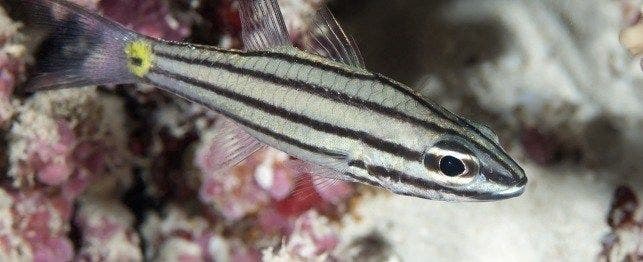
Choosing a Cardinalfish
Cardinalfish are widely distributed throughout the world’s tropical seas, mostly along reefs, but also in tidal pools and mangrove swamps. They are classified in the Apogonidae family and are small predatory fishes that sport various shades of reds, yellows or brown. Many species have distinct stripes and spots, and none grows to more than five inches in length. Their most distinguishing characteristic is their pair of unusually large eyes, which scientists believe is what allows them to see better at night when they feed on small invertebrates and fishes. These little fish usually hide out for most of the day under overhangs and other nooks.
Some cardinalfish have evolved the habit of playing dead when attacked or frightened, so don’t be overeager to flush away your pet unless you are absolutely sure it’s not merely reacting to a scare of some kind.
Although in nature you will find schooling cardinalfish, it’s not a good idea to add more than two to any aquarium, and, ideally, those two should be male and female. As juveniles, cardinalfish will peaceably school in your aquarium, but as they grow older dominant males begin to establish their pecking orders. Once a dominant male has chosen his mate, he will often harass the others to death – literally. Success stories vary when it comes to keeping odd numbers of cardinalfish. To avoid problems, it may be easier to stick with pairs and, in some cases, only a single pair.
Overall, these species are quite hardy to keep in a home aquarium, making them popular among hobbyists. They require a diet of meat and vegetable foods and the usual water-quality ranges for sustaining a healthy reef tank. Cardinalfish are usually shy eaters. They accept just about any food, but they need a little more time than other fish to acclimate to a new environment and may not eat during that period. Feeding them live brine shrimp during the acclimation process has often been the key to getting them used to their new surroundings. Many species of cardinalfish are commonly available for the home aquarium.
Varieties of Cardinalfish
- Pyjama. Sphaeramia (Apogon) nematopterus is an easily obtainable species that comes from the Pacific Ocean. It is usually brownish or yellowish, with large reddish eyes and a band that runs vertically along the middle portion of its body. Its tail end is spotted with polka dots ranging from brown to red. This is among the most shy and peaceful species and several can be kept together with few problems, but don’t overdo it. They are still cardinalfish and will become slightly more aggressive should they feel the need for some elbow room. A group of six or eight in a large (150-gallon-plus) reef aquarium can be a stunning sight.
- Banggai. Pterapogon kauderni is a cardinalfish that was discovered only in the 1930s and wasn’t available to the aquarium trade for another 20 years. These fish are found only along the shores of the Sulawesi Islands in the Indonesian archipelago and were first collected off Banggai island. Unlike its relatives, the Banggai cardinalfish is active during the day and will accept both frozen and dried foods. This little cardinalfish usually doesn’t grow to be much more than three inches in length – and that’s quite large for its species. Like its Pyjama relative, it is relatively peaceful, although Banggai fanatics maintain that no more than two should be kept in medium-sized tanks unless they are all of the same sex. It is a strikingly beautiful fish with a round, black-and-white-striped body and elongated fins and its hardiness make it one of the most popular aquarium fish overall.
- Gold-striped. Apogon cyanosoma is another popular Pacific cardinalfish. It is nocturnal and has a series of longitudinal yellow and gold stripes on a brownish body. Like its relatives, it is quite hardy and will accept just about any food.
- Several Atlantic cardinalfish that are commonly available include the flamefish (Apogon maculates) and the barred flamefish (Apogon binotatus). These fish are bright red, as their name implies, with a series of dark marks on their bodies. They are common in nature around reefs and rocky shores and are often found darting among the spines of sea urchins or hiding along ledges. The barred variety has two dark bands on its posterior. Like the others, this fish prefers some live brine shrimp on occasion, but will accept almost anything you give it.